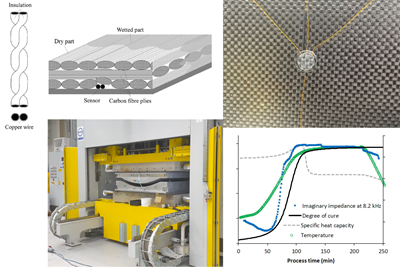The evolution, transformation of DEA from lab measurements to industrial optimization
Over the years, dielectric analysis (DEA) has evolved from a lab measurement technique to a technology that improves efficiency and quality in composites production on the shop floor.
Share
Netzsch DEA 288 Ionic, a lab-based dielectric measurement system. Source (All Images) | SensXPERT
In the fast-paced industrial environment of today’s plastics and composites manufacturing, ensuring product quality and optimizing processes are essential. Manufacturers face unique challenges, such as precisely controlling material properties and immediately responding to process variations. However, this becomes even more complex as consumers demand increased recycled and/or bio-based content, creating a cascade of uncertainties in materials and processes. Advanced measurement techniques are crucial to maintaining reliable, high-performance products and operational efficiency for a competitive advantage.
One such advanced measurement technique is dielectric analysis (DEA), a technique that measures the dielectric properties of materials (e.g., permittivity and conductivity) as they cure or undergo phase transitions. These dielectric properties provide valuable insights into the molecular dynamics and structure of the materials, enabling characterization and optimization of plastics and composites molding and curing processes.
Traditional DEA techniques are primarily confined to laboratory settings, where they offer high precision and reliability. These lab-based DEA measurements are often conducted using dielectric spectroscopy, a technique for measuring the dielectric properties of a material as a function of frequency. Spectroscopy is typically performed using network analyzers, which measure impedance and dielectric properties to evaluate electrical response and stability, or LCR meters, which measure inductance, capacitance and resistance.
Fundamentals of DEA
The fundamental principle of DEA involves applying an alternating voltage to a material and measuring its response in terms of the resulting current and phase shift between the voltage and current. In short, it penetrates the material with an electric voltage and measures the time it needs to respond. This response is influenced by the material’s molecular structure and dynamics, providing insight into its behavior and properties. Key concepts include:
- Permittivity (ε): This measures how much electric field the material can store. It provides insight into the material’s ability to be polarized by an electric field, which is crucial for understanding molecular interactions and structural changes.
- Conductivity (σ): This measures the material’s ability to conduct electric current. It is directly related to the mobility of charge carriers within the material, indicating the progress of curing or other chemical processes.
- Phase transitions and curing processes: DEA is particularly valuable for the in-process monitoring of phase transitions (e.g., from liquid to solid) and curing behavior in polymers and composites. It can track the entire process in real time, offering precise control over manufacturing conditions.
Evolution of analyzing material behavior
DEA was first developed in the 1980s at the Massachusetts Institute of Technology (MIT) in the U.S., driven by the pioneering work of David D. Day. His effort laid the groundwork for understanding and using dielectric properties to analyze material behavior.
In the decades following its development, DEA became a widely adopted tool for analyzing material properties in controlled lab settings. Early DEA applications focused on providing highly accurate data for understanding the molecular dynamics of materials, particularly polymers and composites. As the technology matured, several companies began exploring its broader application in manufacturing environments.
By the 2000s, companies like Lambient Technologies (Cambridge, Mass., U.S.) began developing sensors that primarily used alternating current (AC) to monitor a wide variety of curing polymers, including epoxies, polyurethanes and fiber-reinforced composites. These sensors provide key insights into reaction rates, viscosity and cure states, which helped optimize manufacturing processes like autoclave curing and pultrusion.
Several trends are set to shape the future of dielectric analysis as industries seek more precise, efficient and sustainable manufacturing processes.
Around the same time, Synthesites (Uccle, Belgium), founded in 2008, introduced direct current (DC) sensors tailored for specific industrial applications such as real-time resin curing in composites production, particularly in aerospace and wind energy sectors. Synthesites’ DC sensors allow for precise monitoring of resin curing, enabling detailed measurements of conductivity and resistivity during the transition from liquid to solid.
While companies like Lambient and Synthesites have advanced DEA for specific applications, the ability to fully integrate DEA into diverse and dynamic manufacturing environments still pose significant challenges. Since then, the technology has evolved further to handle the variability and real-time demands of industrial production lines.
Netzsch: Transition from lab to manufacturing
Building on the foundation of MIT’s work, Netzsch (Selb, Germany), a global company developing precision measurement technology, acquired Micromet Instruments and began developing DEA technology further, pushing DEA into more complex manufacturing environments.
One of the key challenges in applying DEA to industrial environments, particularly for advanced materials like carbon fiber-reinforced polymers (CFRP), is the material’s electrical conductivity, which often causes short circuits in dielectric sensors.
To address this, Netzsch developed coated sensors, which achieve accurate dielectric measurements even in electrically conductive materials. These sensors overcame a significant barrier, enabling manufacturers to gather real-time data on material behavior during processing, even in demanding environments like CFRP component production. This innovation, coupled with Netzsch’s long-standing expertise in material science, laid the groundwork for taking DEA beyond static lab measurements into dynamic, real-world applications.
In addition, it paved the way for the creation of the sensXPERT concept in 2019, which aimed to advance DEA from a measurement technology to an integrated solution that improves efficiency and quality control in series manufacturing processes. The concept received funding from Netzsch shareholders in 2020. The first product created was capable of real-time communication with manufacturing machines and integrating material kinetics with in-mold material behavior through machine learning models (see sensXPERT’s webinar series on this topic). In 2021, Netzsch Process Intelligence GmbH was founded to commercialize the sensXPERT technology.
Transforming DEA into an industrial tool
A pivotal moment in the evolution of sensXPERT was the recognition that traditional methods for analyzing DEA data were labor-intensive, limited and lacked standardization. With no existing software capable of correlating DEA data to actionable insights like the degree of cure (DoC) or crystallization, sensXPERT responded by building a dedicated data science team to tackle these challenges.
This led to the creation of a robust tech stack equipped with sophisticated algorithms and visualization tools. These tools not only process DEA data in real time but also correlate it with lab results to deliver accurate, actionable insights into material behavior during production. The integration of machine learning models has transformed the system’s capability, enabling it to predict material property changes and dynamically adjust manufacturing parameters based on real-time data, significantly improving process efficiency and product quality.
Shown here is an example of sensXPERT’s DEA technology predicting degree of cure (DoC). As the part is being processed, the prediction becomes more precise, and with it, the cycle can be dynamically adjusted to end at the point at which the processor’s desired DoC is reached.
Another crucial step was the incorporation of cloud computing and advanced software solutions, which facilitates seamless communication between DEA equipment and production systems on the shop floor. This digital infrastructure enables sensXPERT to operate as a software- and data-driven platform. While hardware remains critical for capturing material data, the entire ecosystem is powered by data science, edge computing, cloud connectivity, and secure cloud operations. For Netzsch, this shift from a hardware-centric to a software-driven approach marks a transformation in the manufacturing industry, moving away from static lab testing toward real-time data processing and predictive analytics.
Through these innovations, sensXPERT aims to gives manufacturers the ability to monitor, predict and dynamically optimize processes — providing deeper control over production quality and efficiency.
Future trends in DEA technology
Several trends are set to shape the future of dielectric analysis as industries seek more precise, efficient and sustainable manufacturing processes. These trends are driven by the growing need for advanced materials, sustainability initiatives and real-time process optimization across various manufacturing sectors.
One of the most significant advancements is the implementation of high-frequency analysis. High-frequency DEA can provide new levels of insight into material compositions and molecular dynamics. Beyond just monitoring phase transitions, high-frequency data allows manufacturers to better understand complex materials and identify opportunities for further optimization.
Another key trend is the continuous integration of AI and machine learning into DEA systems. By combining real-time sensor data with predictive models, AI-driven systems can offer dynamic process adjustments autonomously that ensure optimal curing, material properties and cycle times. Machine learning will enable these systems to “learn” from previous production cycles, improving accuracy and efficiency over time.
Moreover, the push for sustainability is leading to advancements in DEA technology that support the use of recycled and bio-based materials. With increasing environmental regulations and the growing demand for eco-friendly products, DEA systems will play a crucial role in ensuring that these materials — which often exhibit greater behavioral deviations during processing — meet performance standards while maintaining process efficiency. The newly founded Avidens consortium is one example of how industry leaders are coming together to leverage technologies like DEA to enhance the processing of recycled materials.
The rise of digital twins is another trend closely tied to the future of DEA. A digital twin is a virtual model of a physical system or process, and DEA data can be integrated into these models to simulate material behavior during manufacturing. This enables manufacturers to optimize processes virtually before implementing changes in the physical world, reducing trial and error and leading to more efficient operations.
Lastly, the integration of cloud computing and Internet of Things (IoT) will further enhance the accessibility and scalability of DEA systems. By connecting DEA sensors and systems to cloud platforms, manufacturers will have real-time access to production data from anywhere, allowing for more seamless remote monitoring, analysis and decision-making. This trend will also foster collaboration between different parts of the supply chain, as stakeholders can share data and insights more easily.
As these trends continue to unfold, DEA will become a more critical tool across a variety of industries, including automotive, aerospace, electronics and renewable energy. The combination of high-frequency analysis, AI integration, sustainability efforts and digital infrastructure will transform DEA into a more powerful and versatile technology that addresses the growing complexities of modern manufacturing.
About the Author
Alexander Chaloupka
Dr. Alexander Chaloupka is a polymer expert at heart. After studying physics, he began his career in the Department of Thermophysical and Chemical Analysis and Rheology at the Fraunhofer Institute for Chemical Technology (Augsburg, Germany). He subsequently continued his professional journey at Netzsch Analyzing & Testing (Selb, Germany). With more than 10 years of experience in R&D, sales and general management, Chaloupka founded sensXPERT, the first Netzsch Group corporate venture, in 2021. www.linkedin.com/in/alexanderchaloupka/
Related Content
ASCEND program update: Designing next-gen, high-rate auto and aerospace composites
GKN Aerospace, McLaren Automotive and U.K.-based partners share goals and progress aiming at high-rate, Industry 4.0-enabled, sustainable materials and processes.
Read MoreThermoset-thermoplastic joining, natural fibers enable sustainability-focused brake cover
Award-winning motorcycle brake disc cover showcases potential for KTM Technologies’ Conexus joining technology and flax fiber composites.
Read MoreJeep all-composite roof receivers achieve steel performance at low mass
Ultrashort carbon fiber/PPA replaces steel on rooftop brackets to hold Jeep soft tops, hardtops.
Read MoreComposite sidewall cover expands options for fire-safe rail components
R&D project by CG Rail explores use of carbon fiber-reinforced thermoplastics and recycled manufacturing scrap to meet fire safety, weight and volume targets.
Read MoreRead Next
Avoiding pitfalls in the design of LFAM composite components
Recoat temperature, part orientation and bead geometry are some key design variables to consider for a successful and reliable large-format additive manufacturing (LFAM) process.
Read MoreTesting to support composite bolted joint analysis
An overview of ASTM Standard Guide D8509, and its coupon-level mechanical testing of design properties for analyzing composite bolted joints.
Read MoreNational Composites Center and Meggitt demonstrate linear dielectric sensor for liquid composites processing
Research at Cranfield University is further developed via RTM part trials in NCC’s Technology Pull-Through Program
Read More












